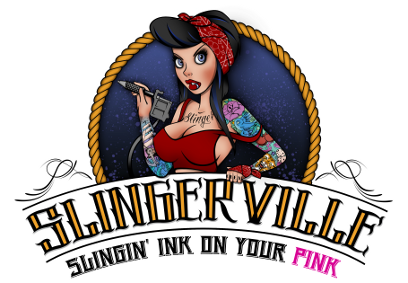 Tattoos and Piercings in the Workplace Common Sense Advice for Workers with Body Art
Tattoos and Piercings in the Workplace Common Sense Advice for Workers with Body Art
Article by: SlingerVille Staff
July 13, 2012
Tattoos and piercings are becoming more accepted as a form of art and expression. They are a big part of the cultural landscape in cosmopolitan cities like Los Angeles. To give you an idea of their rise in popularity here are a few figures. Thirty years ago, 1 in 100 people in this country had tattoos. Now 1 in 10 Americans have them, and one-third of those aged 25 to 30 have tattoos. While society is becoming more liberated and expressive, and piercings and tattoos become part of mainstream culture, some employers are still having a hard time wrapping their heads around body art in the workplace.
What are my rights?
If your company tells you that you can’t wear piercings or reveal your tattoos at work, they aren’t doing anything illegal. Don’t look to the legal system to protect workers who have body art. The law covers discrimination on the grounds of race, color, religion, age, nationality, origin and gender. The one exception may be if you’re a Hindu with a nose ring, which could be a religious observation.
But there are limits. Your company can’t use tats or piercings as an excuse to fire you. A company can, on the flipside, use it as an excuse not to hire you. I’ll cover more reasons for this later.
Many companies have policies that prohibit tats and piercings that are generally outlined in their handbook and/or employee manual. If the policy is new, it may be given out in memo form (or they may revise the current employee handbook). An employer may change a dress code at any time, with or without warning. To cover their derrières legally, the employer will generally give the new guidelines in written form. If an employer does change the dress code, it must be applicable to all employees.
What’s all the hoopla?
In a recent Vault.com survey, employers and employees were asked about tattoos and piercings in the workplace. 60 percent of employers said that they were less likely to hire a candidate with tats or piercings. Their main concern was how the company would be viewed and/or represented. Although the demand for skilled workers is high and filling jobs has been difficult, some managers are willing to pass on workers who they believe could tarnish the company image.
But why do people think less of those with body art or piercings? Some people still associate tattoos with bikers, sailors, criminals, gang members — the pariahs of society. You might see it as self-expression and free speech, but your boss (or potential boss) perceives it as being rebellious, calling attention to yourself, and not being part of the team.
Many employers have a cookie cutter mentality of how their workers should dress and be perceived. Surprisingly, Starbucks, the McDonald’s of the coffee world, doesn’t allow their baristas to show tats or piercings; all tats must be covered up and piercings removed. They’re going for the crisp, clean look and want to let their coffee — rather than the worker’s appearance—do the talking. If you don’t like the Starbucks policy, you might try serving coffee at a smaller, local coffeehouse.
The times they are a’ changing
While some employers cringe at bodywork and piercings, others are embracing it. If you choose a position where you don’t interact with clients, or are pursuing an artistic career, you’re more likely not to have a problem at work. Here is the official policy of some employers at the time of this writing:
• The nation’s largest retailer, Walmart, doesn’t allow facial piercings (i.e. eyebrow, nose or lip). They do allow tattoos that aren’t offensive; ‘offensive’ tattoos must be covered up.
• Borders, one of the nation’s largest book sellers, views body art and piercings as something that makes a worker more interesting and a definite plus.
• Ford Motor Company allows everyone from Senior Executives on down to have tattoos and piercings. The only exception is that factory workers are asked to refrain from piercings that could endanger factory settings and/or worker safety.
• Wahoo’s, a California-based chain of fish taco restaurants, allows their employees to strut their tattoos in the restaurants and in the corporate office (specifically graphic designers, and even the owner).
If you have tattoos and piercings how should you handle it at work?
Walking into work (or an interview) with a giant dragon on your arm probably isn’t a good idea. Modest tats (ones that can be covered up with your pants or a shirt sleeve and/or are small in size) are probably okay. You can take out some of your earrings if you have multiple piercings and/or a nose or eyebrow ring. Or, go for studs instead of large hoops. The piercing through the septum (the one that looks like a bull ring) and large earplugs aren’t usually well received. Large tats (especially ones on your neck or arms) and tongue piercings seem to concern employers the most.
Many tattoo establishments and artists now have consultations with the customers before tattooing them. They ask them to really think about the ramifications of having a tattoo on the neck and other areas that are exposed. Many younger people don’t think about the consequences or the permanence of tattoos. Better to go with a tattoo on the upper arm that could be covered up by a short-sleeved shirt if necessary.
Another good idea is camouflage. Cover your tats with concealer or band-aids. Women can wear bangles or other large bracelets to cover tats on their wrists and still be quite stylish. You can choose to wear long sleeved shirts or long pants and women can wear thick tights and/or strappy heels to conceal tats on their legs and ankles.
Some piercings can’t be left without jewelry all day long. You can use retainer jewelry, which are just clear pieces of plastic to keep your piercings open, or wear clear or flesh-colored plastic balls on your tongue ring. Another option is to go small; choose a very small silver ball for a nose ring, so it will be a little less conspicuous.
The Vault.com survey revealed that 70 percent of the people with tattoos whom they surveyed concealed them at work, while 30 percent didn’t. A good gauge might be to look around your office (or come into the office to look around before your interview) and see if others are wearing their piercings and not concealing their tats. If there is nothing in your employee manual, you can remove and cover up until you’re sure. Many states are at-will employment and have initial 90-day trial periods, so if you really like your job you must weight the importance of your body art and piercings against continued employment.
A Word from the Writer
You may wonder what makes me know so much about this subject. Sure, I did research, but I have also indulged in body art. For the first time in over 10 years, I have been asked to cover up my tats and remove my nose ring. I received a phone call from Human Resources before I even started my current position to let me know that I had already broken the dress code with my nose ring (I covered up the tats on my multiple interviews there).
Although I have a creative position in an agency and have worked at much more conservative places than this (and have been allowed to ‘be myself’), I have to abide by the rules. Why? Because this is one full-time job that I definitely want to keep.
Source: http://www.workingworld.com/articles/tattoos-and-piercings-in-the-workplace
Login to comment
Comments

